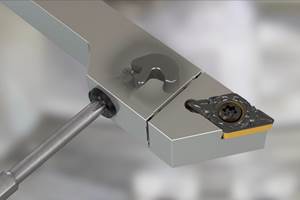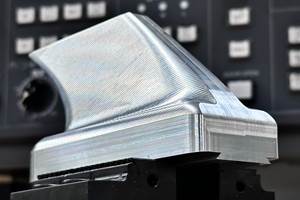CMM Locks In Inspection And Productivity
This company, established more than 140 years ago, manufactures a high volume of brass padlocks annually. They are made on two large rotary transfer machines with drilling capabilities. The company is also doing reverse engineering for tooling purposes for other machines it uses in its manufacturing and assembly departments.
Share






The Wilson Bohannan Company (Marion, Ohio), established more than 140 years ago, manufactures a high volume of brass padlocks annually. The locks, primarily used in industrial and utility applications, are sold as the WB brand. They are made on two large rotary transfer machines with drilling capabilities. The company is also doing reverse engineering for tooling purposes for other machines it uses in its manufacturing and assembly departments.
The company's primary mode of inspection was to check diameters and hole locations by using a combination of pin gages and a special fixture fitted with dial indicators on a granite surface plate. The pin gages checked the diameters and the fixture checked the hole location.
"Total inspection time was 3 to 4 hours, which greatly hindered production because the unit that machines the parts is set up and unable to be released for production until the first ten pieces are successfully inspected and approved," explains Mark Williams, vice president of engineering.
"The inspection process was delaying the machine start up, which in turn was reducing our production yield," he continues. However, there were more problems than just the initial runs. "After start up, we would perform periodic checks of parts, but we would continue to run the machine because of the lengthy inspection process. Because our inspector couldn't check enough parts to ensure the quality we demanded, we were never completely comfortable with the results."
To make matters worse, there are areas of the holes, such as at the bottom of the 0.111-inch diameter tumbler pinholes, which are difficult to access and therefore required destructive testing. "We had to cut apart locks to make accurate measurements," says Mr. Williams. It was clear that this inspection process had to change.
Mr. Williams evaluated the company's fairly demanding accuracy requirements (hole diameter ± 0.001 to 0.002 and repeatability 0.0005), which was very important. Then he took into consideration physical attributes of the part and access to holes, both of which presented positioning and measuring approach problems.
"The lock tumbler pinholes had an opening of only 0.111 inch at the top and were 5/8 inch deep, the diameter of the hole at the bottom being critical," says Mr. Williams. "When we realized there was no way to conventionally hold the part and take measurements reliably and productively with repeatability, we began to see that a CMM that was direct computer controlled (DCC), eliminating human intervention, would probably be our only alternative."
Still, there were hurdles to get over, such as size. The CMM probe stylus tip alone is 0.080 inch, leaving a mere 0.015 clearance around the ruby tip in the hole. "Once we found that the CMM offered a reliable fixturing base, that the stylus cleared the holes and that the measuring routines were automated and highly accurate, there was no doubt in my mind," says Mr. Williams. "A CMM was the only way to go."
After carefully reviewing various CMMs, Mr. Williams selected a Starrett Premis DCC model, with a 20-18-16-inch (X, Y, Z) measuring envelope and Starrett Apogee Software. "We went with the Starrett CMM for a variety of reasons, but primarily because of the machine design and construction."
Another important benefit the Starrett system provides is the ability to deploy reverse engineering through the Apogee software. "Apogee improves productivity and accuracy," says Mr. Williams. "Now when we develop a new part, we do it first on the CAD system and export the CAD file in IGES format. Then we import the file to the Premis, grab the holes and diameters and make instant inspections or evaluations. Apogee works really nice—it's so much easier for the operator to write and run part inspection programs."
Since their inspection process changed, Wilson Bohannan has seen the difference. "The Starrett CMM has reduced the time it takes to inspect our locks to just a few minutes, which greatly saved on work hours," says Mr. Williams.
The company has also been able to deliver a higher quality product more consistently, which is high on its radar screen. "We now inspect locks with a higher level of accuracy," says Mr. Williams. "We have had very few problems and no regrets. In fact, our system was already paid for through productivity gains in the first 2 years."
Related Content
Quick-Change Tool Heads Reduce Setup on Swiss-Type Turning Centers
This new quick-change tooling system enables shops to get more production from their Swiss turning centers through reduced tool setup time and matches the performance of a solid tool.
Read MoreLean Approach to Automated Machine Tending Delivers Quicker Paths to Success
Almost any shop can automate at least some of its production, even in low-volume, high-mix applications. The key to getting started is finding the simplest solutions that fit your requirements. It helps to work with an automation partner that understands your needs.
Read MoreCustom Workholding Principles to Live By
Workholding solutions can take on infinite forms and all would be correct to some degree. Follow these tips to help optimize custom workholding solutions.
Read MoreOrthopedic Event Discusses Manufacturing Strategies
At the seminar, representatives from multiple companies discussed strategies for making orthopedic devices accurately and efficiently.
Read MoreRead Next
AMRs Are Moving Into Manufacturing: 4 Considerations for Implementation
AMRs can provide a flexible, easy-to-use automation platform so long as manufacturers choose a suitable task and prepare their facilities.
Read MoreMachine Shop MBA
Making Chips and Modern Machine Shop are teaming up for a new podcast series called Machine Shop MBA—designed to help manufacturers measure their success against the industry’s best. Through the lens of the Top Shops benchmarking program, the series explores the KPIs that set high-performing shops apart, from machine utilization and first-pass yield to employee engagement and revenue per employee.
Read More



















